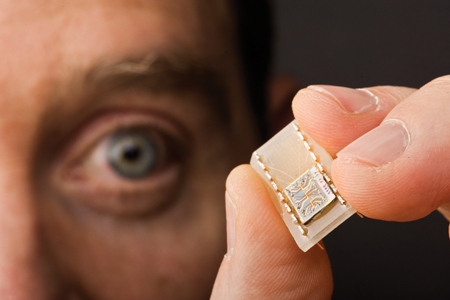A research team led by Mike Lilly at Sandia National Laboratories has noticed a voltage increase of up to 25% in two nanowires separated by a few nanometers. The finding provides a better understanding on the incorporation of nanowires in the building of nanocircuits for next-generation devices.
 Mike Lilly observes two individually powered nanowires, embedded one above the other, in a few atomic layers of Sandia-grown crystal. The unique test device already has yielded new information about nanoworld electrical flows. (Photo by Randy Montoya)
Mike Lilly observes two individually powered nanowires, embedded one above the other, in a few atomic layers of Sandia-grown crystal. The unique test device already has yielded new information about nanoworld electrical flows. (Photo by Randy Montoya)
The research team developed a test device using gallium-arsenide nanowire structures, which are easily breakable but have superior electronic control and can be produced at lower cost. To build the test device, the team placed the nanowires one over the other and isolated them vertically using a highly pure home-grown crystal having a thickness of 15 nm, a distant scale required by future-generation devices.
This setup allows the team to feed and control the electrical inputs separately to the nanowires, as each wire is placed on its independent platform. Lilly has a special fascination towards understanding the behavior of nanowires as a challenge in single-dimensional fundamental science. Electrons can be transmitted only in one direction in single-dimensional wires. Lilly said that his test device will help to understand the difference between single-dimensional, two-dimensional and three-dimensional conductors.
Coulomb force, which causes the Coulomb ‘drag’ effect, is one of the causes for the disparity. Since the force varies inversely with the square of the distance, the effect will be high between the wires placed at nanodistances, making the electrons in one wire to feel the movement of the individual electrons in the other wire though the same force cannot be felt in normal microelectronics. The first wire requires more energy due to the increase in resistance caused by the Coulomb force.
The amount is too small to measure but the voltage difference in the other wire can be measured, Lilly said. The Coulomb force offers negative source at one wire and positive at the other, resulting in a voltage increase in the opposite direction in order to retain the electrons in position, he added. The one-dimensional wire must generate a Luttinger liquid, a hypothetical model that explains electron interactions in a one-dimensional conductor, he said. Lilly’s research is mainly focused on studying the Luttinger liquid.